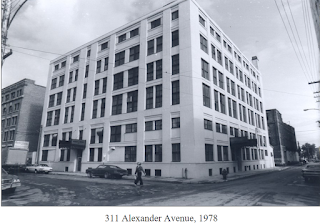2024
52 Ancestors in 52 Weeks
Week 8
Prompt – Heirloom
 | ||
| Christening Gown |
Bill's mother (Clara) told me that she did custom work as a seamstress. She sewed wedding dresses and pretty much whatever was asked of her. Clara said this was Ida Bachmann's business and it kept her quite busy.
As an aside I asked Clara if her mother taught her to sew. Clara was an exceptional seamstress herself. And to my surprise she told me her mother did not teach her to sew. Ida had tried to teach Clara but Ida thought it was better, quicker and easier for her to do it herself. Clara went on to explain that she had trouble working the sewing machine tread peddle and coordination in general. Clara would do dishes as her mother sewed. Clara said she learned by “absorption” She really didn't learn to sew until after she was married and Tony bought her an electric sewing machine.
Ida Bachmann married Arthur Jahnke on 24 Jun 1917. Arthur was living in the small town of Hatton, Saskatchewan and thus the married couple lived there after the marriage. Arthur and his cousin had a general store in Hatton. I'm sure Ida Jahnke's seamstress business kept her busy in Hatton as well.
Soon Ida and Art were expecting their first child. On the 5 Apr 1919, Elsie Jahnke was born. In the time leading up to the birth, Ida worked on the christening gown for her newborn daughter to be baptized in. Clara said she had finished it by the time Elsie was born.
 | ||
| Ida Jahnke Holding Elsie Jahnke in The Christening Gown |
The photograph is over 100 years old and thus not all that clear.
Ida Jahnke used a pattern however it was mostly hand sewn. The intricate embroidery work was all done by hand. The eyelets of the sleeve accommodated a ribbon – blue for boys and pink for girls. Also there was small embroidered roses, blue and pink that were attached at the top of the gown.

Children Who Wore This Christening Gown.
Elsie Jahnke (Ida's daughter) 1919
Herbert Jahnke (Ida's son ) 1924
Clara Jahnke (Ida's daughter) 1928
Arthur Hack ( Ida's grandson) 1941
Elmer Hack ( Ida's grandson) 1943
Dennis Jahnke (Ida's grandson) 1952
Gloria Jahnke (Ida's granddaughter) 1954
William Hoffart ( Ida's grandson 1954
Noreen Jahnke (Ida's granddaughter) 1955
Elaine Hoffart ( Ida's granddaughter) 1958
Norma Hoffart ( Ida's granddaughter ) 1963
Jill Hoffart (Ida's great-granddaughter) 1978
Miranda Churko ( Ida's great-granddaughter) 1980
Jacqueline Hoffart (Ida's great-granddaughter) 1981
Roxanna Reed (Ida's great-granddaughter) 1990 (Dedication)
Anthony Reed (Ida's great-grandson)- 1991 (Dedication)
Alexander Reed ( Ida's great-grandson) 1993 (Dedication)
Daniel Armstrong (Ida's great-grandson) 1994
Joshua Stauber (Ida's great-grandson) 1995
Christina Armstrong ( Ida's great-granddaughter) 1996
Nicole Stauber (Ida's great-granddaughter) 1998
Alanna Hoffart ( Ida's great-great granddaughter) 1998
Michael Armstrong ( Ida's great-grandson) 2000
Norma Armstrong (Nee: Hoffart) has inherited the christening gown. After 101 years the gown was retired after Michael Armstrong's baptism. It is too old and fragile. Norma has talked about having it framed in an archival frame box. I don't think she has done it yet.
The christening gown is truly a treasured piece for The Jahnke Family. It is an heirloom.
Wendy






%20Mennonite%20-%20Copy1.jpg)

%20Mennonite%20-%20Copy2a.jpg)












